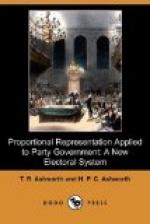The objection to this unit is that when there are several parties, part of the seats only can be allotted on full units, and the rest have to be allotted to those parties which have the highest remainders or fractions of a unit, and this unduly favours small parties, who do not poll even a single unit. The rule to divide the total votes by the number of seats increased by one, which was first proposed by Mr. H.R. Droop, reduces slightly the number of seats allotted on remainders, and was adopted by the canton of Soluthern in 1895. In Belgium a third plan, devised by Professor D’Hondt, of Brussels, is used, which is designed to prevent any seats being allotted on remainders. This unit is evidently smaller than either of the others, and is to be found by trial. It is only necessary that the sum of the quotients obtained by dividing it into each of the lists shall be equal to the number of seats to be filled.
Suppose a five-seat electorate in which 6,000 votes are divided among four parties, who poll 2,500, 1,850, 900, and 750 votes respectively. Then if we take one-fifth, or 1,200 votes, as the unit, the result would be the following:—
(1) 2,500 = 2 units of representation + 100 remainder = 2 seats.
(2) 1,850 = 1 unit of representation + 650 remainder = 1 seat.
(3) 900 = unit of representation + 900 remainder = 1 seat.
(4) 750 = unit of representation + 750 remainder = 1 seat.
If the Droop unit of one-sixth, or 1,000 votes, be used, the result will be different:—
(1) 2,500 = 2 units of representation + 500 remainder = 2 seats.
(2) 1,850 = 1 unit of representation + 850 remainder = 2 seats.
(3) 900 = unit of representation + 900 remainder = 1 seat.
(4) 750 = unit of representation + 750 remainder = seat.
By the third method any number of votes between 834 and 900 will be found to comply with Professor D’Hondt’s condition, and the result would, in this instance, be the same as by the Droop method. Although the highest number was at first used, the lower limit has been adopted in the new bill.
In no case can the proportional distribution be considered satisfactory. If the electorates are small, and the number of parties large, accurate proportional representation is quite out of the question. In Switzerland, however, the electorates are made to contain sometimes as many as 30 seats. The effect of such large electorates must be in time to encourage the formation of a great number of small factions. At the same time there is not so much incentive to split up the parties as by the Hare system.
Passing now to the selection of party candidates, none of the methods can be said to ensure the election of those most in general favour. When electors are allowed to cumulate on individual candidates, the favourites of sections within the party will be elected. If, on the other hand, they are allowed to cumulate on party lists, all votes thus given are ineffective in the selection of the successful candidates. It may be noted that although the nomination of candidates in lists by party organizations is less in accordance with the practice of British countries than the individual candidature of the Hare system, there is nothing to prevent one candidate being nominated to stand in the place of a party.




